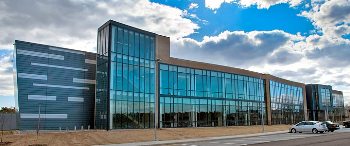Apr 12 2013
Doors opened today, April 11, 2013, at the Interdisciplinary Science Building (ISB), a new world-class research facility at the U.S. Department of Energy's (DOE) Brookhaven National Laboratory where scientists will work to drive breakthrough solutions to the nation's energy challenges.
 The new world-class Interdisciplinary Science Building at Brookhaven Lab is an 87,700-square-foot facility containing 60 standard laboratories, four specialty labs, and offices, where researchers will collaborate to tackle America's most pressing energy challenges.
The new world-class Interdisciplinary Science Building at Brookhaven Lab is an 87,700-square-foot facility containing 60 standard laboratories, four specialty labs, and offices, where researchers will collaborate to tackle America's most pressing energy challenges.
Representatives from DOE, Brookhaven Lab, and Brookhaven Science Associates (BSA) joined elected officials and members of the Brookhaven Lab community at the ISB for a dedication ceremony to celebrate the facility's opening.
"Energy innovation plays a direct role in the continued prosperity and security of the United States, and the ISB is at the forefront of the Department of Energy's investment in a vibrant future," said DOE Office of Science Director Bill Brinkman. "The research done here will have long-lasting and far-reaching impacts."
"I don't think there's a more important problem in the world right now, both near- and long-term, than energy," said New York State Senator Kenneth P. LaValle. "There is no simple solution, however I am positive about this: The men and women working in this new interdisciplinary space will help create the technologies that will power us into the future."
This new hub for energy research at Brookhaven Lab will provide customized laboratories for multidisciplinary research teams at the ISB working to tackle America's most pressing energy and environmental challenges. Specifically, scientists at the ISB will engineer and optimize materials with the goal of developing breakthrough technologies for batteries, biofuels, and solar panels.
"Scientists at the ISB will be well positioned to help answer our nation's call for energy security," said Ron Townsend, Board Chair for BSA—the company that manages Brookhaven Lab for DOE—and Executive Vice President, Global Laboratory Operations, for Battelle.
Brookhaven Laboratory Director Doon Gibbs said, "This is an exciting day for Brookhaven Lab and the nation. The ISB—with its cutting-edge, 21st century laboratories—is a gateway to exciting possibilities and opportunities in basic energy science and technology, including applications. It's where scientists from different backgrounds and disciplines will work together to answer tough questions and address our critical energy challenges to make the world a better place."
Overview of the Facility
The ISB is an 87,700-square-foot facility, where researchers with different scientific specialties will team up to take on significant energy challenges. The building contains offices, 60 standard laboratories, and four specialty labs with unique features, including a humidity-controlled dry room, where researchers can safely assemble and test new lithium-ion batteries; two ultra-low vibration laboratories housing the new Spectroscopic Imaging Scanning Tunneling Microscope (SI-STM) used to explore materials' electronic structure at the atomic scale; and the OASIS laboratory, which connects a lab customized for molecular beam epitaxy (MBE)—a process researchers use to fabricate new materials one atomic layer at a time—with one of the ultra-low vibration labs via a vacuum-locked system. This system allows scientists to transport MBE-created samples directly to the SI-STM microscope without exposing them to air, which can diminish sought-after properties.
The building also contains conference spaces and areas designed to foster collaboration among scientists. The ISB is located within walking distance of several other major Lab research facilities that will help advance work and foster collaboration, including the Center for Functional Nanomaterials, the National Synchrotron Light Source (NSLS), and NSLS-II, which is scheduled to begin operations in 2014.
"The ISB provides state-of-the-art laboratory space for materials science research, including world-leading, high-precision experimental environments," said Associate Laboratory Director for Basic Energy Sciences Jim Misewich. "The ISB will enable research to understand complex materials at a level that is unprecedented and will advance solutions for 21st century energy technologies."
"The Laboratory has made a commitment to grow its impact and the ISB is a critical facility in which some of our best researchers are solving some of the most challenging problems," said Associate Laboratory Director for the Global and Regional Solutions Gerry Stokes.
Sustainable Design and Construction
Sustainable design and energy efficiency were significant factors that influenced construction of the ISB. The ISB design reduces use of potable water by 55 percent and energy consumption by 37 percent, which contributes toward an overall cost avoidance of 29 percent when compared to benchmark laboratory designs.
In addition to energy-cost-saving strategies such as heat recovery, and high-efficiency lighting systems and laboratory equipment, the facility was built with certified environmentally-sustainable wood, recycled materials, and materials from vendors within the region to reduce the building's overall carbon footprint by minimizing the distance materials traveled to the site. The ISB design also includes strategies to conserve water at the facility.
"From the start, principles of sustainable design guided our concepts and basic architecture for the facility to create a laboratory building that is energy efficient and respectful of the environment," said ISB Project Manager Peggy Caradonna.
The total cost for the project was $66.8 million, most of which was provided by the DOE Office of Science. The Lab also received approximately $18 million from the American Recovery and Reinvestment Act to accelerate construction in April 2009.
"The ISB will not only provide scientific advances that help preserve the environment, but the facility itself stands as a testament to thoughtful and sustainable development," said Marcus Jones, Associate Director for the Office of Safety, Security, and Infrastructure in the DOE Office of Science. "The entire project, from planning to construction, was handled expertly by all involved."